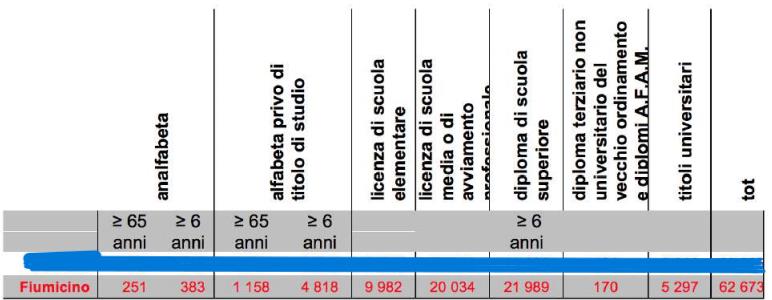Demography
With its 80,738 residents (ISTAT data 2021), Fiumicino is the 4th largest municipality in Lazio by population, with a population density of 377.5 inhabitants per square kilometer.
The municipality covers an area of 213.88 square kilometers and consists of 34 districts.
Fiumicino was established in 1992 through a referendum; prior to that, it was part of the XIV district of the Municipality of Rome. Since its establishment, the resident population has nearly doubled, from 42,444 inhabitants initially.
The gender composition of the population is balanced (49.9% male and 50.1% female), and the foreign resident population is 11.8% (up from 7.3% in 1993).
The average age is 42.8 years, notably lower than both the national average (45.7 years) and that of Rome (45.8 years). The municipality has an aging index of 118.66 (national average is 187.9), positioning Fiumicino as one of the municipalities with a higher proportion of young residents.
Education and Employment
Educational Level (ISTAT data 2011)
The human resources in the Municipality of Fiumicino are slightly behind the capital in terms of education, as evidenced by two key statistical indices. The non-completion rate of the first cycle of schooling (ages 15-62) is 6.11 for Fiumicino, compared to 4.82 for Rome. The rate of possession of a high school diploma (ages 19-44) is 56.54 for Fiumicino, compared to 65.25 for Rome.
However, these indices are higher than the national average (8.61 and 53.27, respectively).

Labor Force and Employment Levels
The population in Fiumicino is generally younger compared to Rome. However, in 2018, the index of active population replacement, which is the percentage ratio between the population close to retirement (ages 60-64) and those about to enter the workforce (ages 15-19), showed that the workforce in Fiumicino is still quite elderly, aligning with the trends observed in Rome and the rest of the country.
The professional profile in Fiumicino reveals a population distribution of 57.7% in the workforce and 42.3% not in the workforce; the percentage of retirees is 16.9%.
From Table 2, it is possible to extract values related to employment levels. The activity rate measures the level of participation in the labor market within an economic system, in good alignment with the data related to the average age and the replacement of the active population.

Commuting
The phenomenon of commuting began to significantly impact Fiumicino around the mid-1980s, due to the population shift from Rome to the municipality’s territories. Although Fiumicino is not a dormitory town, about 40% of its resident population works outside the municipal boundaries. It should be noted that labor mobility is high in both directions, both to and from Fiumicino. Commuting into the area mainly revolves around the Leonardo da Vinci International Airport, while outbound commuting is directed toward a wide range of geographical destinations and diverse employment sectors.
Around 20% of the resident population commutes daily to the capital for study purposes.
Demography
With its 80,738 residents (ISTAT data 2021), Fiumicino is the 4th largest municipality in Lazio by population, with a population density of 377.5 inhabitants per square kilometer.
The municipality covers an area of 213.88 square kilometers and consists of 34 districts.
Fiumicino was established in 1992 through a referendum; prior to that, it was part of the XIV district of the Municipality of Rome. Since its establishment, the resident population has nearly doubled, from 42,444 inhabitants initially.
The gender composition of the population is balanced (49.9% male and 50.1% female), and the foreign resident population is 11.8% (up from 7.3% in 1993).
The average age is 42.8 years, notably lower than both the national average (45.7 years) and that of Rome (45.8 years). The municipality has an aging index of 118.66 (national average is 187.9), positioning Fiumicino as one of the municipalities with a higher proportion of young residents.
Education and Employment
Educational Level (ISTAT data 2011)
The human resources in the Municipality of Fiumicino are slightly behind the capital in terms of education, as evidenced by two key statistical indices. The non-completion rate of the first cycle of schooling (ages 15-62) is 6.11 for Fiumicino, compared to 4.82 for Rome. The rate of possession of a high school diploma (ages 19-44) is 56.54 for Fiumicino, compared to 65.25 for Rome.
However, these indices are higher than the national average (8.61 and 53.27, respectively).

Labor Force and Employment Levels
The population in Fiumicino is generally younger compared to Rome. However, in 2018, the index of active population replacement, which is the percentage ratio between the population close to retirement (ages 60-64) and those about to enter the workforce (ages 15-19), showed that the workforce in Fiumicino is still quite elderly, aligning with the trends observed in Rome and the rest of the country.
The professional profile in Fiumicino reveals a population distribution of 57.7% in the workforce and 42.3% not in the workforce; the percentage of retirees is 16.9%.
From Table 2, it is possible to extract values related to employment levels. The activity rate measures the level of participation in the labor market within an economic system, in good alignment with the data related to the average age and the replacement of the active population.

Commuting
The phenomenon of commuting began to significantly impact Fiumicino around the mid-1980s, due to the population shift from Rome to the municipality’s territories. Although Fiumicino is not a dormitory town, about 40% of its resident population works outside the municipal boundaries. It should be noted that labor mobility is high in both directions, both to and from Fiumicino. Commuting into the area mainly revolves around the Leonardo da Vinci International Airport, while outbound commuting is directed toward a wide range of geographical destinations and diverse employment sectors.
Around 20% of the resident population commutes daily to the capital for study purposes.












